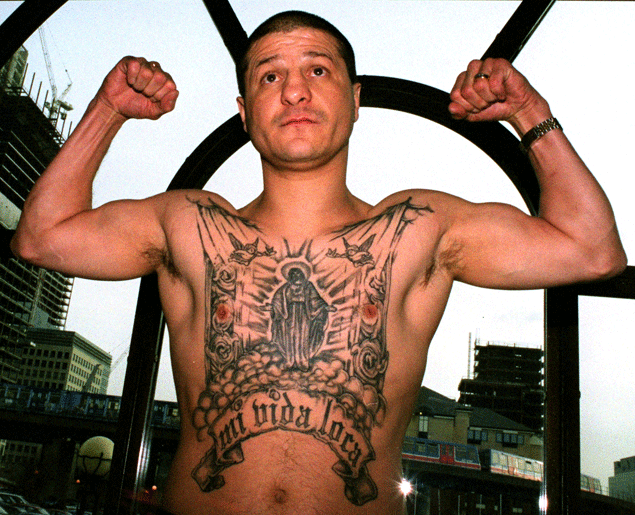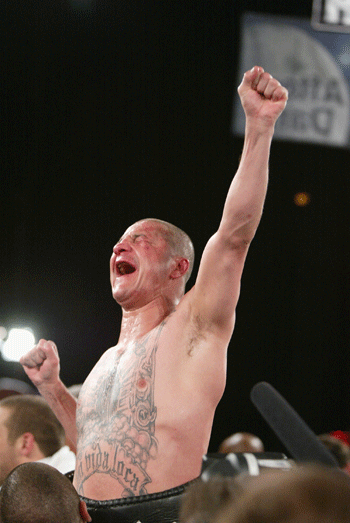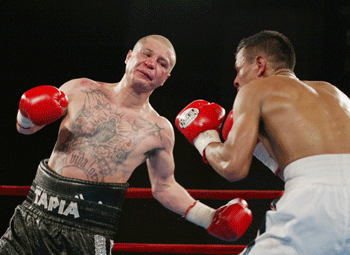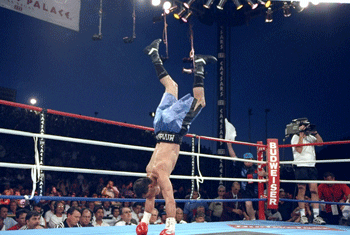Tapia’s ‘vida loca’ comes to a close, a warrior finally finds peace


For all but eight of his 45 years on earth, Johnny Tapia waged a war within himself. One side radiated a charisma that few could resist, a fighting spirit that yielded to no man and an enthusiasm so infectious that it could pull others out of their own doldrums, at least for a time.
As luminous as his personality was inside the ropes and with his public, the dark side of Johnny Tapia was turbulent, chaotic and self-destructive. Triggered by witnessing the latter moments of his beloved mother’s torment — rape, hanging, stabbing, kidnapping and ultimate death — the young Tapia never again felt the consistent sense of safety, comfort and assuredness. As of Sunday night, Tapia’s evening spirit joined her’s in the next life.
His body was found during the early evening hours in his Albuquerque residence by his wife Teresa and early reports indicate no foul play was involved.
Though the news of his sudden death produced an initial shock, the arc of his life suggested an early demise because the demons that raged within him prompted Tapia to engage in a variety of dangerous behaviors. His chronic substance abuse once led to a three-and-a-half year ban from professional boxing as well as countless run-ins with the law, jail stints, hospitalizations and fits of rage. In his 2006 autobiography “Mi Vida Loca: The Crazy Life of Johnny Tapia,” the fighter revealed he had overdosed on cocaine on his wedding night and had been declared clinically dead five times.
 Sadly, for the world of boxing and for those who loved him or admired him from afar, Tapia couldn’t rise a sixth time.
Sadly, for the world of boxing and for those who loved him or admired him from afar, Tapia couldn’t rise a sixth time.
In contrast to his life beyond the ropes, Tapia’s 23 years in professional boxing were filled with many triumphs, triumphs that may lead to eventual enshrinement in the International Boxing Hall of Fame. Along with legendary light heavyweight champion Bob Foster, Tapia was Albuquerque’s greatest champion. His 48-fight unbeaten string from the start of his career is among the longest such streaks in boxing history and along the way he captured major titles at junior bantamweight, bantamweight and featherweight.
His greatest run of success occurred at 115 pounds, where he won the vacant WBO crown by 11th round TKO over Henry Martinez before an emotionally charged crowd at the Pit in Albuquerque. Over the next 40 months he registered 13 defenses of the WBO belt and spectacularly added the IBF title by defeating cross-town rival Danny Romero via dazzling decision. Besides Romero, other junior bantamweight title fight victims included former titleholders Rolando Bohol (KO 2), Hugo Soto (W 12) and Rodolfo Blanco (W 12) as well as onetime U.S. Olympian Arthur Johnson (W 12), grizzled veteran Willy Salazar (KO 9) and Jorge Barrera (KO 3), brother of Marco Antonio Barrera.
After cleaning out the super flyweights, Tapia earned his second divisional belt, the WBA’s bantamweight strap, by out-pointing hard-punching Ghanaian Nana Konadu but lost the belt – and his undefeated record – in his first defense against Paulie Ayala. That Tapia’s unanimous decision loss to Ayala was voted 1999’s Fight of the Year by THE RING was hardly surprising, for Tapia always pursued victory with a frightening ferocity. On this night, Ayala, a fierce battler himself, was up to the challenge.
Eight months later Tapia won his second version of the 118-pound title, this time the WBO belt, by out-pointing the 42-1 Jorge Eliecer Julio at The Pit. He defended that belt once (W 12 Pedro Javier Torres) but he gave up that title to pursue Ayala’s WBA bantamweight title in a big-money rematch. Because Tapia couldn’t squeeze his body back down to 118, the fight went on as a non-title affair but was no less disappointing in terms of action and drama. Ayala again emerged a narrow decision winner.
Tapia had one more title triumph in him, for in April of 2002 the 35-year-old veteran scored a hotly disputed majority decision over Manuel Medina to wrest the IBF featherweight belt. It would prove to be his last victory in championship competition, for he never risked that title and never vied for one again.
The next nine years were a series of fits and starts. His last spotlight fight was a decision loss to Marco Antonio Barrera in November of 2002, after which he went 7-2 (2 KOs) in a stretch marked by long bouts of inactivity and razor-thin victories and defeats. He suffered the only knockout loss of his career at age 43 against journeyman Sandro Marcos in September 16, 2005 and Tapia fought as recently as last June when he decisioned fellow former titleholder Mauricio Pastrana over eight rounds. His final record stands at 59-5-2 (30).
For most people, the idea of engaging in combat within a boxing ring would seem unsettling, uncomfortable and even frightening. But for Tapia, the squared circle was a sanctuary, his venue for validation and a place of sanity and order – two states that were in short supply within the rest of his life. In the ring Tapia could see his opponent and strike him with his trademark precision and whenever he ended the competition as a winner or a loser, the result was at least definitive.
Tapia was energetic and even joyous during his fights, and his behavior during his final fight with Pastrana was typical. Trula Howe of uscombatsports.com perfectly captured Tapia’s in-ring character in the following paragraph:
 Each connection made by Pastrana, however, was acknowledged with a nod and a grin by veteran Tapia, who favored the crowd with various antics throughout the eight-round match-up: Turning around to say hello to a fan in the middle of an early round, lassoing one fist while delivering hooks with the other, running in place like one of the Three Stooges, even stopping in the eighth round for a ring cleanup, during which he playfully smacked the referee on the rump.
Each connection made by Pastrana, however, was acknowledged with a nod and a grin by veteran Tapia, who favored the crowd with various antics throughout the eight-round match-up: Turning around to say hello to a fan in the middle of an early round, lassoing one fist while delivering hooks with the other, running in place like one of the Three Stooges, even stopping in the eighth round for a ring cleanup, during which he playfully smacked the referee on the rump.
But once the ring combat ended and Tapia left the arena, his other war resumed. The never-ending mental anguish came at him from all angles and he couldn’t figure out a way to make it stop. None of the people who cared for him – most of all his extraordinary wife Teresa – could do anything to quiet the storm. The reports of various legal run-ins, hospitalizations and drug overdoses persisted with unsettling regularity and in late September of 2010 rumors briefly circulated that he had died. Those were quickly shot down by Team Tapia, as were reports that he had contracted hepatitis.
On Sunday night, Tapia’s long struggle with himself came to an end and the boxing world is left to mourn his passing. Over the next few days fans and media alike will remember the dynamic performances, the bubbly personality and the extraordinary fighting heart he exhibited time and time again.
Here’s hoping that in the next life Tapia will finally experience the peace that tragically escaped him in this one.
*
Photos / Warren Little, Jed Jacobsohn and Al Bello of Getty Images
Lee Groves, a boxing writer and historian based in Friendly, W.Va., can be emailed at [email protected]. He is a full member of the BWAA, from which he has won seven writing awards, including a first-place for News Story in 2011. He has been an elector for the International Boxing Hall of Fame since 2001 and is also a writer, researcher and punch-counter for CompuBox, Inc. He is the author of “Tales From the Vault: A Celebration of 100 Boxing Closet Classics.” To order, please visit Amazon.com or e-mail the author to arrange for autographed copies.














